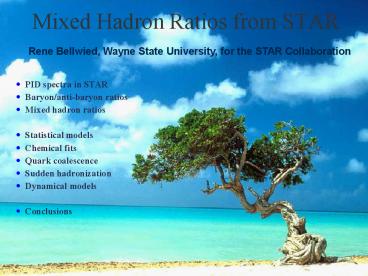Mixed Hadron Ratios from STAR
1 / 29
Title:
Mixed Hadron Ratios from STAR
Description:
Ratios calculated for central events at mid-rapidity, averaged over experimental ... 14% central. Quark coalescence for mixed ratios. X-/p. Quark coalescence ... –
Number of Views:38
Avg rating:3.0/5.0
Title: Mixed Hadron Ratios from STAR
1
Mixed Hadron Ratios from STAR
Rene Bellwied, Wayne State University, for the
STAR Collaboration
- PID spectra in STAR
- Baryon/anti-baryon ratios
- Mixed hadron ratios
- Statistical models
- Chemical fits
- Quark coalescence
- Sudden hadronization
- Dynamical models
- Conclusions
2
p / K / p - slope parameters
dE/dx-analysis with TPC
dE/dx , kink, V0 analysis comparison for charged
and neutral Kaons
mid-rapidity y0.1
3
Slope Parameters via V0 PID (y0.5)
Preliminary pt 0.5-3.5 GeV/c
Larger pt-range than dE/dx, better
characterization of flow
4
STAR B/B Ratios
Ratio approaching 1.0 as strangeness content
increases
STAR preliminary
0.94 0.13
Ratios calculated for central events at
mid-rapidity, averaged over experimental
acceptance in pt.With the assumption of equal
acceptance of particle and antiparticle no
corrections have to be applied
5
Energy Evolution of B/B Ratio
Production of baryons through pair processes
increases dramati-cally with ?s still not
baryon free
STAR preliminary
Pair-process production is larger than baryon
transport
(ISR)
Note 2/3 of protons from pair processes, yet pt
dist. the same as antiprotons
6
Statistical models
- Braun-Munzinger et al. (hep-ph/0106066)
- - Follows curve for ltEgt/ltNgt 1 GeV at
freezeout - - Usesphenomenologicalparameterization
J. Cleymans K. Redlich,PRL 81 (1998) 5284
7
T and mB according to thermal model
Assumption strangeness in complete equilibrium
i.e. strangeness saturation factor gs 1
8
Strangeness production
Lines of constant lS where
ltEgt/ltNgt 1 GeV
Braun-Munzinger et al.hep-ph/0106066
9
Wroblewski factor evolution
dependent on T and mB dominated by Kaons
Wroblewski factor
PBM et al., hep-ph/0106066
total
mesons
baryons
hidden strangeness mesons
Peaks at 30 A GeV in AA collisions due to strong
mB dependence
10
Statistical model fit at 130 GeV
11
Chemical fit result
Central
K/K-
Chemical freeze-out parameters Tch 1794
MeV mB 514 MeV ms -0.82.0 MeV gs 0.99
0.03 c2/dof 1.5
BRAHMS PHENIX PHOBOS STAR
X/X-
p-/p
p/p
L/L
K/p
K-/p-
K/h-
p/p
Ratio (chemical fit)
K-/h-
p/p-
K0s/h-
K0/h-
L/h-
L/h-
f/h-
X-/h-
X/h-
Model M.Kaneta, Thermal Fest (BNL, Jul 2001),
N.Xu and M.Kaneta, nucl-ex/0104021
Ratio (data)
12
K/p ratio as a function of beam energy
saturation ?
13
K/p ratio as a function of beam energy
14
Experimental L/p
4p yields
15
Strange Baryon production as a f(centrality)
Note spectra are not feed-down corrected
L yields are from fits to Boltzmann h- yields
are power law fits
Saturation ?
ConclusionStrange baryon over charged particle
ratio is constant
16
Implications for ratios
Statistical errors only Mid-rapidity ratios
(0.2)
Braun-Munzinger et al.hep-ph/0106066
17
Implications for ratios
Statistical errors only Mid-rapidity ratios
(0.2)
(PRELIMINARY)STAR 130 GeV14 central
(L/p????????
Braun-Munzinger et al.hep-ph/0106066
18
Sensitivity to multi-strange baryons
Stat. model cant get a ??/p? ratio above 0.09 in
this phase space!
D. Magestro private communication
19
Sensitivity to multi-strange baryons
X/p?
Braun-Munzinger et al.hep-ph/0105229 Thermal
fit resultsin T 174 MeV, mB 46 MeV. Grand
canonicalensemble, unlikeprevious model
Statistical errors only
(Preliminary) STAR 130 GeV14 central data
Ratios
Model gets K-/p?,L/p- correct, butmisses on X
ratios!!!
T (MeV)
20
Quark-Counting Ratios (ALCOR model)
Biro, Levai, Zimanyi Phys. Lett. B347 (1995) p6
Assumption formation of a constituent quark
plasma with subsequent coalesence of the quarks
into hadrons
21
Quark-Counting Ratios from STAR data
Measured
Predicted
Quark-counting ratios are consistent with each
other
Will change slightly with feeddown corrections
(not included here)
STAR Preliminary
Statistical errors only
22
Quark coalescence for mixed ratios
As mB -gt 0, sensitivity of the model to
particle/antiparticle ratios is lost. Must look
at ratios of dissimilar species to resolve model
accuracy.
130 GeV
X-/p?
Quark coalescence (ALCOR)
Quark coalescence does better with X????
23
L/p ratio correction factors
- Lm LS0XW
- LS0??????????? Lm
- pm p(0.64Lm0.52S)
- p 0.88 (LS0?? 0.52S p1.01 (LS0??
- pm/Lm 0.74 0.73 p/(LS0??
- p/(LS0?? 1.?? pm/Lm 1.01
24
Sudden hadronization model (1999)
25
Sudden hadronization model (2001)
J. Rafelski inhep-ph/0111467
Large ratio at AGS (and SPS) still not understood
26
Stat. model 200 GeV predictions
Use parameterization
(CAUTION! Really for 4p ratios)
Becattini et al.PRC 64 (2001) 024901
Statistical errors only
27
Stat. Model Predictions Revisited
Use parameterization
(Preliminary)STAR 130 GeV Data
(CAUTION! Really for 4p ratios)
Becattini et al.PRC 64 (2001) 024901
Statistical errors only
28
What about other models ?
29
Some Conclusions































